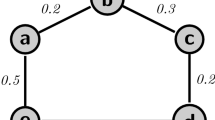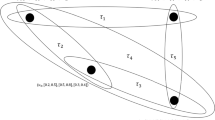Abstract
Picture fuzzy graph (PFG) is a useful tool in fuzzy graph theory that can be used to model a variety of real-world problems involving uncertainty caused by unknown, changing, and indeterminate data. PFG might be more fruitful at solving confusing problems than fuzzy graph (FG) and intuitionistic fuzzy graph (IFG). In this study, some interesting properties and results for the PFGs have been presented by using the concepts of strong arcs. The notions of covering in a PFG, strong node covering, strong arc covering, strong independent set, and matching number have been introduced for PFG. Moreover, we also devised the conception of paired domination, strong paired domination, and strong paired dominating set for a PFG. Furthermore, many interesting properties of these conceptions are established. Additionally, the strong paired domination numbers of complete PFG and complete bipartite PFG have been worked out. In addition, many various intriguing aspects of strong paired domination have been examined.







Similar content being viewed by others
References
Akram M, Akmal R (2017) Intuitionistic fuzzy graph structures. Kragujevac J Math 41:219–237
Akram M, Davvaz B (2012) Strong intuitionistic fuzzy graphs. Filomat 26:177–196
Akram M, Dudek WA (2011) Interval-valued fuzzy graphs. Comput Math Appl 61(2):289–299
Akram M, Dudek WA (2013) Intuitionistic fuzzy hypergraphs with applications. Inf Sci 218:182–193
Atanassov K (1986) Intuitionistic fuzzy sets. Fuzzy Sets Syst 20:87–96
Atanassov K (2012) Intuitionistic fuzzy relations (IFRs). On Intuitionistic Fuzzy Sets Theory, pp 147–193
Chartrand G (2006) Introduction to graph theory. Tata McGraw-Hill Education, New York
Chen SM, Hong JA (2014) Fuzzy multiple attributes group decision-making based on ranking interval type-2 fuzzy sets and the TOPSIS method. IEEE Trans Syst Man Cybernet 44:1665–1673
Chen SM, Lee LW (2011) Fuzzy interpolative reasoning for sparse fuzzy rule-based systems based on interval type-2 fuzzy sets. Expert Syst Appl 38:9947–9957
Chen SM, Chang YC, Pan JS (2012) Fuzzy rules interpolation for sparse fuzzy rule-based systems based on interval type-2 Gaussian fuzzy sets and genetic algorithms. IEEE Trans Fuzzy Syst 21(3):412–425
Cuong BC, Kreinovich V (2013) Picture Fuzzy Sets-a new concept for computational computational intelligence problems. In: 2013 third world congress on information and communication technologies (WICT 2013). IEEE. pp 1–6
Dubois D, Prade H (2005) Interval-valued fuzzy sets, possibility theory and imprecise probability. In: EUSFLAT Conf, pp 314–319
Jan N, Nasir A, Alhilal MS, Khan SU, Pamucar D, Alothaim A (2021) Investigation of cyber-security and cyber-crimes in oil and gas sectors using the innovative structures of complex intuitionistic fuzzy relations. Entropy 23(9):1112
Kauffman A (1973) Introduction a la Théorie des Sous-emsembles Flous. Masson et ice.
Khan SU, Nasir A, Jan N, Ma ZH (2021) Graphical analysis of covering and paired domination in the environment of neutrosophic information. Math Prob Eng 2021:1–27
Knyazeva M, Belyakov S, Kacprzyk J (2018) Topological ordering on interval type-2 fuzzy graph. In international conference on theory and applications of fuzzy systems and soft computing. Springer, Cham, pp 262–269
Mendel JM, John RI, Liu F (2006) Interval type-2 fuzzy logic systems made simple. IEEE Trans Fuzzy Syst 14:808–821
Nasir A, Jan N, Gumaei A, Khan SU (2021a) Medical diagnosis and life span of sufferer using interval valued complex fuzzy relations. IEEE Access 9:93764–93780
Nasir A, Jan N, Gumaei A, Khan SU, Albogamy FR (2021b) Cybersecurity against the loopholes in industrial control systems using interval-valued complex intuitionistic fuzzy relations. Appl Sci 11(16):7668
Nayeem A, Pal M (2005) shortest path problem on a network with imprecise arc value. Fuzzy Optim Decis Making 4:293–312
Pal M, Samanta Rashmanlou H (2015) some results on interval-valued fuzzy graphs. Int J Comput Sci Electron Eng 3(3):205–211
Parvathi R, Karunambigai MG (2006) Intuitionistic fuzzy graphs. In Computational intelligence, theory and applications. Springer, Berlin, pp 139–150
Pramanik T, Samanta S, Pal M (2016a) Interval-valued fuzzy planar graphs. Int J Mach Learn Cybern 7(4):653–664
Pramanik T, Samanta S, Sarkar B, Pal M (2016b) Fuzzy Ø-tolerance competition graphs. Soft Comput 21:3723–3734
Rashmanlou H, Pal M (2013a) Some properties of highly irregular interval-valued fuzzy graphs. World Appl Sci J 27(12):1756–1773
Rashmanlou H, Pal M (2013b) Balanced interval-valued fuzzy graphs. J Phys Sci 17:43–57
Rashmanlou H, Samanta S, Pal M, Borzooei RA (2015) A study on bipolar fuzzy graphs. J Intell Fuzzy Syst 28:571–580
Rashmanlou H, Pal M (2014) Isometry on interval-valued fuzzy graphs. arXiv preprint http://arxiv.org/abs/1405.6003.
Rosenfield A (1975) Fuzzy graphs. In: Zadeh LA, Fu KS, Shimura M (eds) Fuzzy sets and their applications to cognitive and decision processes, pp 77–95
Sahoo S, Pal M (2015) Intuitionistic fuzzy competition graph. J Appl Math Comput 52:37–57
Sahoo S, Pal M, Rashmanlou H, Borzooei RA (2017) Covering and paired domination in intuitionistic fuzzy graphs. J Intell Fuzzy Syst 33(6):4007–4015
Samanta S, Pal M (2011a) Fuzzy tolerance Graphs. Int J Latest Trends Math 1:57–67
Samanta S, Pal M (2011b) Fuzzy threshold graphs. CIIT Int J Fuzzy Syst 3:360–364
Samanta S, Pal M (2012a) Bipolar fuzzy hyper graphs. Int J Fuzzy Logic Syst 2:17–28
Samanta S, Pal M (2012b) Irregular bipolar fuzzy graphs. Int J Appl Fuzzy Sets 2:91–102
Samanta S, Pal M (2013) Fuzzy k-competition graphs and p-competition fuzzy graphs. Fuzzy Inf Eng 5:191–204
Samanta S, Pal M (2015) Fuzzy planar graph. IEEE Trans Fuzzy Syst 23:1936–1942
Samanta S, Pal A, Pal M (2014) New concepts of fuzzy planar graphs. Int J Adv Res Artif Intell 3:52–59
Samanta S, Akram M, Pal M (2015a) m-step fuzzy competition graphs. J Appl Math Comput Spring 47:461–472
Samanta S, Pramanik T, Pal M (2015b) Fuzzy coloring of fuzzy graphs. Afrika Mathematika 27:37–50
Samanta S, Sarkar B, Shin D, Pal M (2016) Completeness and regularity of generalized fuzzy graphs. Springerplus 5:1979–2003
Zadeh LA (1965) Fuzzy sets. Inf Control 8:338–353
Zuo C, Pal A, Dey A (2019) New concepts of picture fuzzy graphs with the application. Mathematics 7(5):470
Acknowledgements
The authors are grateful to the Deanship of Scientific Research, King Saud University for funding through Vice Deanship of Scientific Research Chairs.
Author information
Authors and Affiliations
Corresponding authors
Additional information
Publisher's Note
Springer Nature remains neutral with regard to jurisdictional claims in published maps and institutional affiliations.
Rights and permissions
About this article
Cite this article
Jan, N., Asif, M., Nasir, A. et al. Analysis of domination in the environment of picture fuzzy information. Granul. Comput. 7, 801–812 (2022). https://doi.org/10.1007/s41066-021-00296-w
Received:
Accepted:
Published:
Issue Date:
DOI: https://doi.org/10.1007/s41066-021-00296-w




